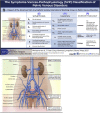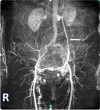Pelvic venous congestion syndrome: female venous congestive syndromes and endovascular treatment options
- PMID: 37076700
- PMCID: PMC10115924
- DOI: 10.1186/s42155-023-00365-y
Pelvic venous congestion syndrome: female venous congestive syndromes and endovascular treatment options
Abstract
Pelvic venous congestion syndrome (PVCS) is a common, but underdiagnosed, cause of chronic pelvic pain (CPP) in women.PVCS occurs usually, but not exclusively, in multiparous women. It is characterized by chronic pelvic pain of more than six months duration with no evidence of inflammatory disease.The patients present to general practitioners, gynaecologists, vascular specialists, pain specialists, gastroenterologists and psychiatrists. Pain of variable intensity occurs at any time but is worse in the pre-menstrual period, and is exacerbated by walking, standing, and fatigue. Post coital ache, dysmenorrhea, dyspareunia, bladder irritability and rectal discomfort are also common. Under-diagnosis of this condition can lead to anxiety and depression.A multidisciplinary approach in the investigation and management of these women is vital.Non-invasive imaging (US, CT, MRI) are essential in the diagnosis and exclusion of other conditions that cause CPP as well in the definitive diagnosis of PVCS. Trans-catheter venography remains the gold standard modality for the definitive diagnosis and is undertaken as an immediate precursor to ovarian vein embolization (OVE). Conservative, medical and surgical management strategies have been reported but have been superseded by OVE, which has a reported technical success rates of 96-100%, low complication rates and long-term symptomatic relief in between 70-90% of cases.The condition, described in this paper as PVCS, is referred to by a wide variety of other terms in the literature, a cause of confusion.There is a significant body of literature describing the syndrome and the excellent outcomes following OVE however the lack of prospective, multicentre randomized controlled trials for both investigation and management of PVCS is a significant barrier to the complete acceptance of both the existence, investigation and management of the condition.
Keywords: Chronic pelvic pain; Embolization; Embolotherapy; Ovarian Vein Embolization; Ovarian varices; Pelvic congestion syndrome; Pelvic varices; Pelvic venous insufficiency.
© 2023. The Author(s).
Conflict of interest statement
EK Rocket medical (Consultant), Guerbet Medical (Advisory board and Consultant), Boston Scientific (Consultant).
EE N/A
NP N/A
DA N/A
AH N/A
Figures






References
-
- Ahlberg NE, Bartley O, Chidekel N. Right and left gonadal veins: an anatomical and statistical study. Acta Radiol Diagn. 1966;4(6):593–601. - PubMed
-
- Ahmed O, Ng J, Patel M, Ward TJ, Wang DS, Shah R, Hofmann LV. Endovascular stent placement for May-Thurner syndrome in the absence of acute deep vein thrombosis. J Vasc Interv Radiol. 2016;27(2):167–173. - PubMed
-
- Asciutto G, Mumme A, Marpe B, Köster O, Asciutto KC, Geier B. MR venography in the detection of pelvic venous congestion. Eur J Vasc Endovasc Surg. 2008;36(4):491–496. - PubMed
-
- Asciutto G, Asciutto KC, Mumme A, Geier B. Pelvic venous incompetence: reflux patterns and treatment results. Eur J Vasc Endovasc Surg. 2009;38(3):381–386. - PubMed
-
- Barge, T. F., & Uberoi, R. (2022). Symptomatic pelvic venous insufficiency: a review of the current controversies in pathophysiology, diagnosis, and management. Clin Radiol. 77:409 - PubMed
Publication types
LinkOut - more resources
Full Text Sources
Medical
